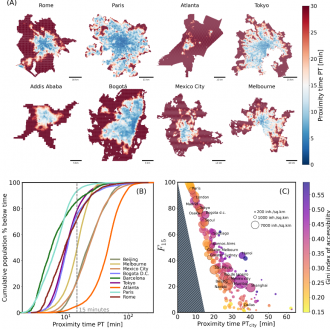Media release
From:
Sustainability: A web-based tool to find 15-minute cities *IMAGES & VIDEO*
Only a tiny fraction of global cities currently meet the definition of a 15-minute city, according to a paper published in Nature Cities. For most existing cities, to become 15-minute cities would require vast relocation of existing services and amenities and/or the addition of an impractical number of new ones. The findings are based on a web-based platform that maps global cities and how close they are to achieving the 15-minute concept.
The 15-minute city concept proposes that a city can function more effectively, equitably and environmentally if essential services and key amenities are accessible to its residents within 15 minutes of travel by public transport. However, transitioning an urban area to a 15-minute city is a challenging prospect and requires efficient urban planning, transportation reform and a commitment to high-quality essential services and resources. While some cities across the world have shown interest in the principles of the 15-minute city, there has not been an easy method to gauge how close a city is to becoming one.
To measure how close cities all over the world are to becoming 15-minute cities, Matteo Bruno and colleagues created a web-based open-access platform using data from the open-source packages GeoPandas and OpenStreetMap. The tool reports the average proximity of urban centres, neighbourhoods and peripheries to essential services and amenities across cities. The researchers quantified how widespread 15-minute cities are now. In their analysis of approximately 10,000 cities, Bruno and colleagues found considerable variation in the percentage of population that actually lives within 15 minutes of essential services, which the authors classify as nine categories: outdoor activities, learning, supplies, eating, moving, cultural activities, physical exercise, services and healthcare. The authors note that this spread is dependent on the city’s culture (for example, how car-dependent it is) and that city centres were better served than peripheral areas; this was common to many cities, including Paris, France, Atlanta, Georgia, and Tokyo, Japan.
The authors note that relying on open data for their tool and analysis may introduce certain biases, including the exclusion of areas with not enough information. They conclude that future research on the state of current 15-minute cities must also include climatic variations and cultural differences between cities in gauging the effective distance between citizens and points of interest.
Multimedia





 Australia; International
Australia; International



